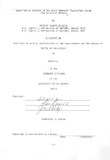| dc.description.abstract | A population of Amaranthus cruentus (UC87) and another of
hypochondriacus (UC99) were subjected to Sl (selfed) family
analysis of genetic variation for plant height, plant weight,
head length, head weight, threshing percentage, seed yield:height
ratio, days to flowering, 500 seed weight, harvest index and seed
yield per plant during the summer of 1982. Mass and recurrent Sl
selections were initiated on the two populations for yield:height
ratio and harvest index. These selections were advanced to
second generation by mass selection in the summer of 1983. The
Sl selection was also done for plant weight in UC87 and days to
flowering in UC99. All generations of these selection
experiments were evaluated together during the summer of 1984.
Population UC87 had significant variation for threshing
percentage, 500 seed weight and harvest index as indicated by Sl
family analysis. High direct and indirect selection gains
indicated presence of additive and additive x additive effects.
This was confirmed for harvest index by component variance
estimates. There were signs of overdominance in Sl selections.
Population UC99 had significant genotypic variation for all
traits except plant weight, head length and head weight. High
direct and correlated selection gains indicated high additive and
additive x additive effects. This was also confirmed by the
genetic component estimates for yield:height ratio and harvest
index. Realized gains from mass selection were higher than their
expected values and the gains from Sl selection. Gains from the
second cycle mass selection were lower than gains from the first
cycle mass selection. These observations were attributed to the
heterogeneity of UC99, which most likely involved competition,
natural selection and higher homozygosity levels. In both
populations mass selection was more efficient than S1 selection.
This suggested a greater role of additive than the dominance
component of variation.
Based on correlation coefficients and multiple stepwise
regression, the best yield predictors were plant height, head
weight, threshing percentage and yield:height ratio. Harvest
index was an important predictor for the yield of UC99 original
population in 1984 only. Yield:height ratio was the most
consistent predictor; the path-coefficient analyses indicated
that most other variables influenced yield through yield:height
ratio. Head weight was also an important indirect path for some
predictors. | |

